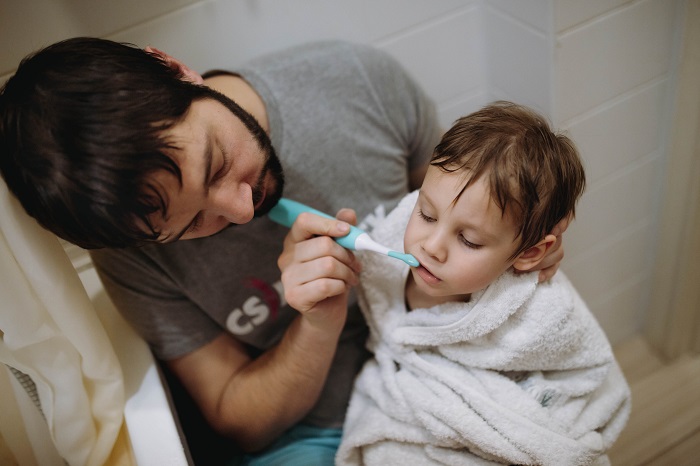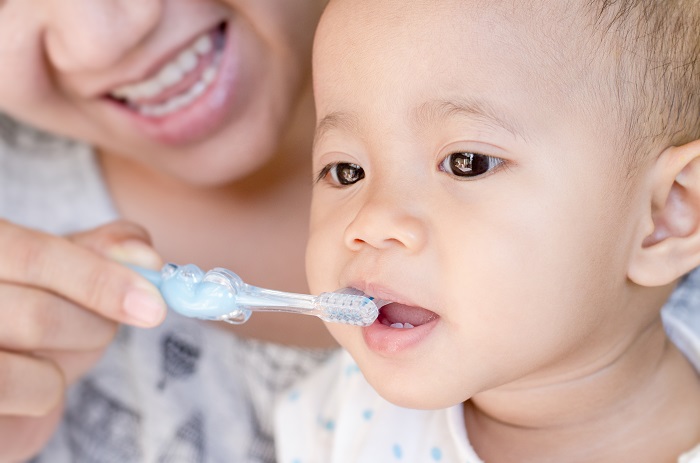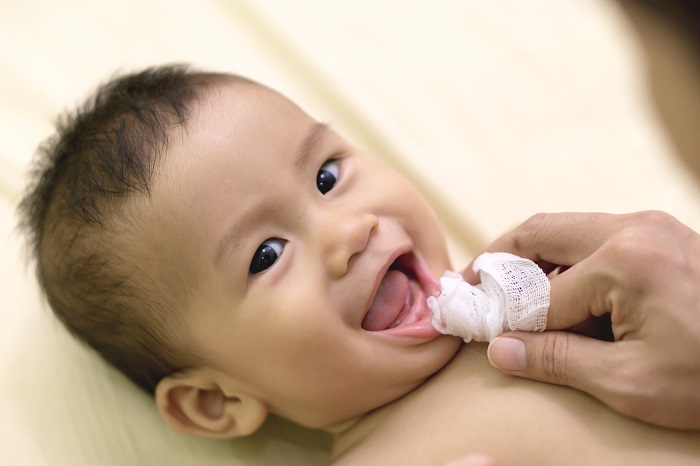Is your toddler on their tooth brushing ‘L’ plates and refusing to cooperate? With tantrums, tears and perhaps some talkback, it can be tough teaching little ones to brush! Dr Rebecca Eggers, owner and principal specialist from Norwest Paediatric Dentistry, talks to us about a helpful approach called ‘Educaring’. This technique encourages you to use respect, communication and empowerment to get your tot to bed with a happy, sparkling smile.
First things first: the importance of brushing
Got a toddler who doesn’t want to brush at all? Or perhaps they’re resisting your help – insisting they can do the brushing themselves. Whatever your situation, we know how tempting it can be to simply ‘give in’ to a pint-sized toddler-tyrant’s demands.
But with toothbrushing, there’s no negotiation. Just like bathing and nappy changing, effective toothbrushing is central to every child’s health and caregiving routine. And if it’s not carried out effectively, your child could develop decay soon after their teeth appear, leading to serious consequences.
What’s more, your child won’t have the fine motor skills to brush properly until they’re eight years old. This means you’ll need to give them a helping hand for several years – even if they’re less than thrilled about it.
So this means:
- yes, brushing is needed every morning and night
- and yes, you – their caregiver – must do the brushing.

Will forcing brushing upon my child have a negative impact?
It’s a question we’re asked a lot. Many parents worry this approach could lead to their child developing a lifelong negative relationship with tooth brushing. Rest assured – this is absolutely not the case! Carrying out brushing with empathy and respect won’t cause negative associations with the activity.
This raises the question: how do you help a resistant child brush – all the while being empathetic and respectful? A good place to start? Magda Gerber’s world-renowned respectful parenting style called the ‘Educaring Approach’ or ‘RIE’ (pronounced ‘rye’).
The basis of Magda’s philosophy is respect for and trust in the child as an initiator, explorer and self-learner. During care activities, the child is encouraged to be an active participant. Parents are encouraged to use these opportunities for interaction, cooperation and mutual enjoyment, rather than a hurried chore.
Below we apply Magda’s teachings to your child’s toothbrushing so that you can create a positive relationship with oral health from day dot.
- Create a familiar routine
Children crave predictability. It gives them comfort and security in a world that is otherwise full of constant transitions and overwhelming new sensations. That’s why toothbrushing needs to be a consistent part of your child’s mornings and nights. For example, at night it might be dinner, bath, teeth… then finally, a book or snuggle in bed.
But of course, routines are rarely set in stone. Your child’s needs will change over time – and their routines will need to change with them. What is important, however, is that you keep an open dialogue about the game plan. And that you get in the habit of explaining each task in order, such as, ‘Let’s put on your pajamas and then get your toothbrush ready’.

- Give them choices
As kids get older, they become more active in their toothbrushing routine. And giving them choices and flexibility will foster this transition. But remember, allowing them complete freedom may mean their teeth are never effectively brushed. That’s why you need to start with some non-negotiables – such as ‘we brush our teeth twice a day, every day’.
Once these non-negotiables are in place, you can start to give a choice between two options – making sure you would be happy with either outcome. For example, perhaps you let them choose between brushing their upper or lower teeth first. Or whether they prefer to sit, stand or lie when you brush their teeth.
- Provide plenty of warning
In your mind, 6pm might be the ideal time for a toothbrushing quest. But your little one might have other plans (deeply attending to secret toddler missions of course). So try to allow them the time and space to explore and play. Then give a gentle warning when it’s nearly time to brush their teeth, such as ‘In five minutes, it’ll be time to pack away those toys and head to the bathroom to brush our teeth.’
Then in four minutes…‘Would you like to pack away the toys yourself before we brush your teeth, or would you like some help?’
Just like a familiar routine, a little mind preparation can make a world of difference to how they react to the experience now and in the future.
- Keep the communication open
Communication during caregiving activities is a key foundation of ‘Educaring’. Madga describes its importance by saying that if she had a stroke that made her non-verbal and dependent like an infant, she would want to be warned before being touched, lifted, fed, sponged, rinsed, dressed, etc.
So, it’s important to use communication to let your child know everything going on in their immediate world, especially if it directly relates to their body.
While it can feel awkward talking to someone who doesn’t talk back, you will quickly get used to it. And young children begin to understand respectful intentions to include them much earlier than we might believe.

What does this look like in practise? Start by calmly explaining how you expect them to behave and reinforce those expectations. And respect that this learning can take time and requires repeated supportive guidance. Perhaps say things like ‘So that I can reach all the way to clean your back teeth I need you to open your mouth nice and wide.’
Or…‘I’m going to move your lips out of the way with my finger so the brush can reach to your gums. Stand nice and still and let your lips go floppy for this.’
For older kids who resist the brush completely, try explaining why we need to clean our teeth and what the consequences of not doing so could look like. Breakdown the steps on how to brush properly, so they know their role in the process.
- Slow it down and focus
Young brains aren’t quite as quick as our adult ones. So when instructing your child on how to brush, allow a few moments between steps for them to register and comprehend exactly what you mean. Think of it a bit like commentating a sporting event – introducing the next step before moving on…
‘Now I’m putting the toothpaste on the toothbrush. Next I’m going to open your lips wide with my finger and put the toothbrush in your mouth. Now I’m moving to your back teeth, we’re going to brush all that food away. Can you say a big ‘ahhh’ so I can reach all the way to the back?’
And as you’ll be aware, children’s attention spans vary. So why not leave the iPad out of sight and temptation? This way, you can both focus on the teeth cleaning task at hand.
- Show they have been seen and heard
Hands and feet flying everywhere. Mouths clamped shut. Head flinging from side to side. Is this a familiar scene at toothbrushing time in your house?
Whatever the reason, it’s important to acknowledge that your child is upset and validate their frustrations. Give them space to share their feelings and discomfort about toothbrushing. After all, the mouth is an extremely sensitive area and having a toothbrush come at you can feel invasive.

Trying saying things like ‘Oh you don’t like me moving your lips away with my finger, lets count to 10 while I’m brushing and then you can have a break.’or ‘I know it’s hard to hold still while I clean your teeth. You feel like hitting me, but I won’t let you. We’ll stop for a moment so that you can calm down.’
Children lashing out during toothbrushing is a common way of testing boundaries. It’s normal and not a reason to rush or stop this important activity.
And even after the trickiest of ordeals, acknowledge and thank them for everything they did do. Like ‘Thank you, I could see you were trying your best. Your teeth are now looking really clean!’
Need a little further help?
If you have a resistant brusher and need more support and advice, visiting a paediatric dentist is a good place to start. With additional years of child-specific training, they’re well placed to help you and your family.
The team at Norwest Paediatric Dentistry are experts at sharing fun and practical tips with both children and parents – for lifelong oral health beyond the dental chair.
And if your child’s brushing anxiety stretches beyond the bathroom and into the dentist’s office? The Norwest team is trained and equipped to help settle anxious children using a range of techniques.
To find out more about their preventive dentistry and other services, visit Norwest Paediatric Dentistry. Currently, the team is available for kids in pain, emergencies and trauma.

